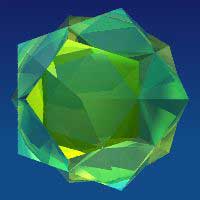|
DODECAHEDRON + ICOSAHEDRON COMPOUND
If we construct the dual of a cube by constructing the mediators of the edges, we obtain an octahedron. The two solids fit together in a nice symmetric way as shown.
We notice that in the construction • the number of red edges is the same as the number of grey edges, since there is a one-to-one correspondence between them; The above argument shows that here we logically expect V = FD, E = ED, and F = VD. We say that the dodecahedron and the icosahedron are dual polyhedra. We can write: the dual of {5, 3} is {3, 5}, and conversely. The illustrated polyhedron is called the dodecahedron + icosahedron compound. It is the compound of a dodecahedron and its dual, a regular icosahedron.
This compound also makes an attractive model. For nets and instructions on making this model, check out this link.
Once more, spend some time playing with the applet, and enjoying this beautiful compound polyhedron. Use the applet to check out the following statements:
Check your answers ... Suppose you want to construct a computer model of this compound. You will need a set of coordinates for each of the vertices.
Suppose you want to construct a computer model of this compound. You will need a set of coordinates for each of the vertices.
From the construction of this compound, we can use our previous coordinates for the dodecahedron: ( and icosahedron:
Notice that we have expressed 30 = 3 x 2 + 3 x 23.
Here are some attractive occurrences of the dodecahedron plus icosahedron compound. References MathWorld: http://mathworld.wolfram.com/Dodecahedron-IcosahedronCompound.html University of Limerick: http://www.ul.ie/~cahird/polyhedronmode/relation.htm |
View the compound
(a) looking directly down on a vertex of the isocahedron
(b) looking directly down on a vertex of the dodecahedron.
Obtaining these numbers is a bit more tricky! |
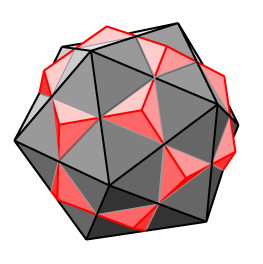
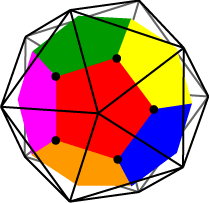
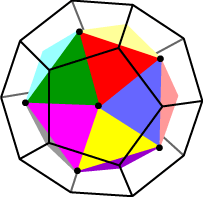
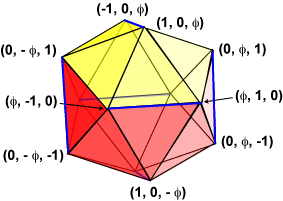 The remaining 30 vertices of the compound are the edge midpoints of (say) the icosahedron. From the figure, we see that these will be:
The remaining 30 vertices of the compound are the edge midpoints of (say) the icosahedron. From the figure, we see that these will be: